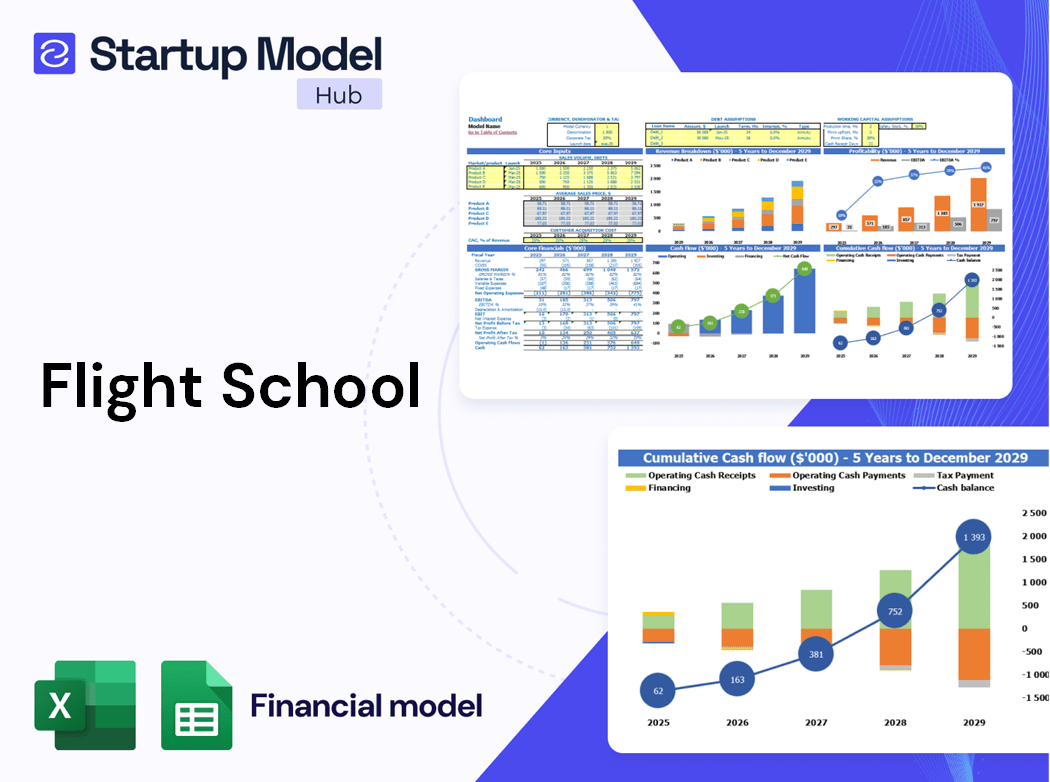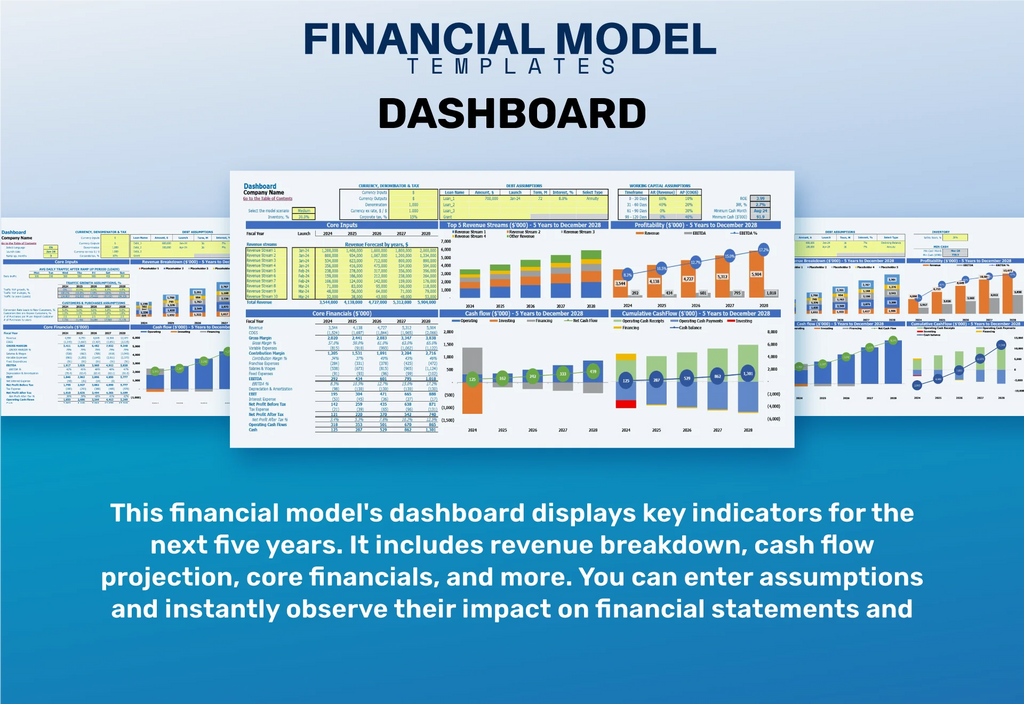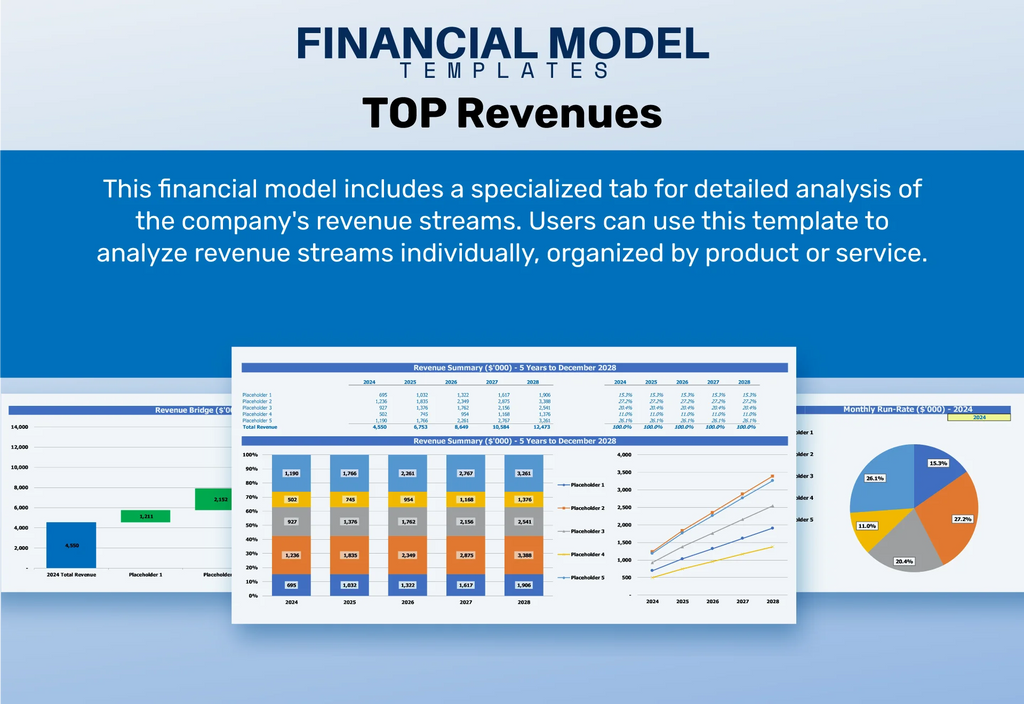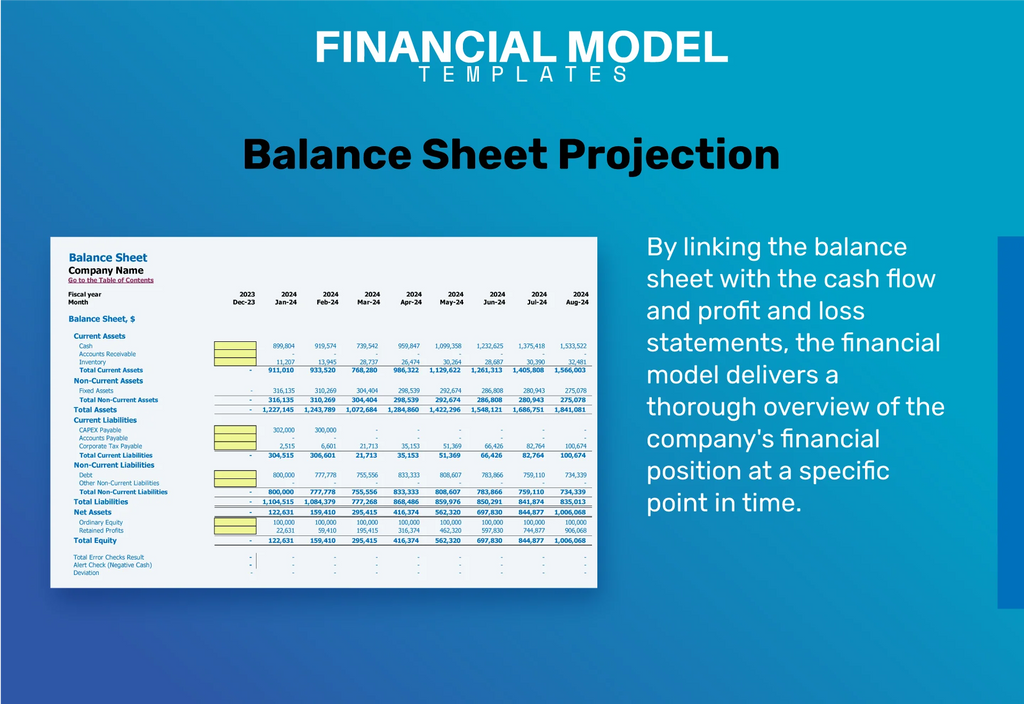Flight School Financial Model

- ✔ 5-Year Financial Projections
- ✔ 100% Editable
- ✔ Investor-Approved Valuation Models
- ✔ MAC/PC Compatible, Fully Unlocked
- ✔ No Accounting Or Financial Knowledge
Flight School Financial Model
Bundle Includes:
-
Financial Model
-
Business Plan
-
Pitch Deck
-
Financial Dashboard
ALL IN ONE MEGA PACK - CONSIST OF:
flight school Financial Model/Business Plan Excel Template
Pitch Deck Template For PowerPoint, Keynote & Google Slides
Business Plan Guide and Business Plan Template in MS Word Format
Financial Dashboard in Excel To Track Your Business Performance
FLIGHT SCHOOL STARTUP BUDGET INFO
Highlights
This five-year flight training program financial model offers a comprehensive cash flow statement template specifically designed for fundraising and business planning tailored to startups and entrepreneurs in the aviation sector. It includes essential aviation school revenue projections, pilot school expense analysis, and flight academy cash flow management tools, enabling users to evaluate potential profitability metrics and make informed decisions. The model incorporates aviation education financial planning strategies, including flight instruction budgeting, funding sources, and tuition pricing strategies, alongside detailed analyses of operating expenses and maintenance costs for training aircraft. Additionally, it provides insights into student enrollment forecasts, pilot licensing financial requirements, and student loan options for flight training, making it an invaluable resource for assessing the financial viability of flight schools before a sale.
This financial model is tailored specifically for flight training programs, addressing key pain points faced by aviation schools, such as revenue projections and expense analysis. By incorporating comprehensive budgeting strategies, it allows for precise cash flow management and financial forecasting, ensuring that operators can smoothly navigate pilot licensing financial requirements and operating expenses. Additionally, the template offers insights into aviation training ROI calculations, student enrollment forecasts, and tuition pricing strategies, helping schools optimize their income streams and effectively manage training aircraft maintenance costs. With user-friendly input tables and charts, the model simplifies the complexities of funding sources and marketing budgets, empowering flight academies to make informed financial decisions for sustainable profitability.
Description
Our flight training program financial model is meticulously crafted to facilitate informed decision-making through comprehensive data analysis and reporting. This aviation school revenue projections tool incorporates essential inputs and tables, enabling a thorough pilot school expense analysis and cash flow management strategy. Our flight school profitability metrics focus on key areas like tuition pricing strategy and training aircraft maintenance costs while also considering student enrollment forecasts and pilot licensing financial requirements. By encompassing aviation program funding sources and student loan options for flight training, our financial forecasting equips you with insights to enhance your operational efficiency and explore diverse aviation education income streams, ultimately promoting sustainable growth and community engagement.
FLIGHT SCHOOL FINANCIAL PLAN REPORTS
All in One Place
To gain a comprehensive understanding of your aviation school’s financial health, utilize the startup costs spreadsheet to analyze revenue projections and expense assessments. This tool provides critical insights into operating expenses, pilot training financial requirements, and potential funding sources. By integrating these financial models, you can effectively strategize tuition pricing, enhance cash flow management, and forecast student enrollment. Additionally, evaluating the training aircraft maintenance costs and marketing budget will refine your profitability metrics, making it easier to plan for sustainable growth and maximize your aviation education ROI.

Dashboard
The pro forma Excel template is an essential resource for analyzing and forecasting cash flow in aviation school financial models. It enables educators to create detailed revenue projections and expense analyses over any timeframe, from monthly to annually. With its user-friendly dashboard, users can visually interpret data through charts and numerical summaries. This tool aids in flight school financial forecasting, helping institutions effectively manage operating expenses and optimize tuition pricing strategies. By leveraging this template, aviation programs can enhance their funding strategies and improve overall profitability metrics.

Business Financial Statements
Our flight training program financial model offers meticulously crafted templates for essential accounting statements, including the pro forma balance sheet, P&L statement, and monthly cash flow analysis. These interconnected statements ensure seamless financial forecasting and clarity, perfectly tailored for presentation to potential investors. By utilizing this structured approach, aviation schools can enhance revenue projections, streamline expense analysis, and optimize cash flow management. This comprehensive financial tool supports effective budgeting strategies, enabling informed decisions regarding tuition pricing, marketing budgets, and funding sources, ultimately driving the profitability of your flight academy.

Sources And Uses Statement
The sources and uses chart within our flight training program financial model is a crucial tool for pinpointing funding sources and identifying potential cash flow leaks. By leveraging this analysis, aviation schools can enhance revenue projections and optimize expense management. It facilitates strategic financial planning, ensuring effective budgeting for flight instruction and maintenance costs. With insights into enrollment forecasts and tuition pricing strategies, flight academies can improve profitability metrics while providing students with informed loan options tailored to their pilot licensing financial requirements. This comprehensive approach is essential for sustainable growth in aerospace education.

Break Even Point In Sales Dollars
Our flight training program financial model includes a break-even chart that illustrates the sales volume needed to cover all fixed and variable operating expenses. This critical tool aids in determining the financial viability of the aviation school by assessing profitability metrics. By utilizing our pro forma financial statements, you can easily adjust assumptions and explore different aviation training cost breakdowns. If initial results aren’t favorable, modify your financial forecasts until the model aligns with your profitability targets, ensuring a sustainable future for your flight academy.

Top Revenue
This financial projection model in Excel features a dedicated tab for an in-depth analysis of the aviation school's revenue streams. By categorizing revenue by product or service, it facilitates more insightful evaluations of the flight training program's financial performance. This comprehensive approach supports effective budgeting strategies and enhances financial forecasting, ensuring informed decisions for sustainable growth. Whether assessing tuition pricing strategies or evaluating operating expenses, this model is indispensable for maximizing profitability and optimizing cash flow management in the aviation education sector.

Business Top Expenses Spreadsheet
This financial plan for our startup features a comprehensive Top Expenses tab, categorizing costs into four primary groups, along with an 'Other' category for miscellaneous expenditures. This structure enhances our flight training program financial model, enabling precise expense analysis and effective budgeting strategies. By clearly delineating operating expenses, we can better manage cash flow and optimize our aviation school revenue projections. This organized approach supports our commitment to financial forecasting, ensuring we meet pilot licensing financial requirements and maintain profitability metrics essential for sustainable growth in aerospace education.

FLIGHT SCHOOL FINANCIAL PROJECTION EXPENSES
Costs
The flight school business plan template in Excel is an invaluable tool for developing a robust financial model. It outlines operating expenses and forecasts, helping users pinpoint funding gaps and address weaknesses. Comprehensive financial projections enhance communication with investors and support loan acquisition. By analyzing aviation school revenue projections and implementing effective budgeting strategies, flight schools can optimize cash flow management and ensure profitability. Additionally, understanding pilot licensing financial requirements and tuition pricing strategies is essential for sustainable growth in the competitive aviation training market.

CAPEX Spending
A detailed capital expenditure (CAPEX) budget is crucial for effective financial forecasting in a flight training program. By incorporating automatic depreciation calculations, our pro forma income statement template streamlines expense analysis for aviation schools. Users can easily apply straight-line or double-declining balance methods, enhancing the accuracy of aviation education financial planning. This approach not only supports student enrollment forecasts but also helps in assessing flight school profitability metrics. By managing operating expenses and evaluating funding sources, flight academies can optimize their marketing budget and tuition pricing strategy for sustained growth and success in pilot training.

Loan Financing Calculator
A loan amortization schedule is essential for managing your flight training program's financial health. Our proforma business plan template includes a detailed amortization schedule with pre-built formulas, clearly outlining monthly, quarterly, or annual repayment amounts. This tool helps aviation schools optimize revenue projections and expense analysis while ensuring effective cash flow management. By understanding principal and interest payments, flight schools can better strategize tuition pricing, track operating expenses, and evaluate funding sources, ultimately enhancing profitability and supporting student enrollment forecasts. Explore how our template can elevate your aviation education financial planning today.

FLIGHT SCHOOL INCOME STATEMENT METRICS
Financial KPIs
The flight school financial model template focuses on key performance indicators (KPIs) tailored for aviation education, including revenue growth, gross margin, and EBITDA margin. It also addresses cash flow management through metrics like the cash burn rate, ensuring robust financial forecasting. Additionally, it aids in investment analysis by evaluating runway and funding needs. Customize your model to suit the specific metrics relevant to your flight academy, such as student enrollment forecasts and pilot licensing financial requirements, for a comprehensive view of profitability and funding strategies. This adaptable framework supports effective financial planning for aviation schools.

Cash Flow Forecast Excel
Effective cash flow management is crucial for any flight training program. Utilizing a robust cash flow forecasting model enables aviation schools to analyze revenue projections, manage operating expenses, and assess profitability metrics. This tool offers insights into student enrollment forecasts and helps in budgeting strategies for flight instruction. By understanding the aviation training cost breakdown and exploring funding sources, schools can optimize their financial planning and improve ROI calculations. Implementing these methods not only enhances operational efficiency but also supports sustainable growth in the competitive field of aerospace education.

KPI Benchmarks
This pro forma template includes a dedicated tab for financial benchmarking, crucial for aviation schools aiming to enhance their flight training program financial model. By comparing industry-specific financial metrics with their performance, schools can gain insights into profitability metrics, operating expenses, and cash flow management. This analysis empowers aviation educators to refine their financial planning strategies, optimize tuition pricing, and develop robust marketing budgets. Ultimately, effective benchmarking aids in identifying funding sources, improving student enrollment forecasts, and enhancing the return on investment for aviation programs.

P&L Statement Excel
The profit and loss statement template in Excel allows for real-time modeling of your aviation school's expenses and revenues, offering a dynamic approach to financial forecasting. Unlike the pro forma cash flow statement, which provides a historical cash movement record, the profit and loss statement incorporates crucial non-cash items like depreciation, ensuring comprehensive financial analysis. This tool is essential for flight training program financial models, enabling effective budgeting strategies and informed decision-making to enhance profitability metrics, manage operating expenses, and optimize your aviation school’s revenue projections.

Pro Forma Balance Sheet Template Excel
This pro forma balance sheet template provides a comprehensive overview of your aviation school's financial health, detailing current and fixed assets, liabilities, and equity. By monitoring accounts receivable, accounts payable, and accrued expenses, you can enhance financial planning. Coupled with a five-year cash flow projection template, it serves as an essential tool for managing flight school operating expenses and forecasting student enrollment. Utilize this resource to optimize flight school profitability metrics and support strategic decisions in tuition pricing and investment analysis, ultimately driving your aviation program's success.

FLIGHT SCHOOL INCOME STATEMENT VALUATION
Startup Valuation Model
This flight school financial model template offers dual valuation methods, ensuring robust financial forecasting for your aviation school. Choose between a discounted cash flow (DCF) analysis or a weighted average cost of capital (WACC) calculation to project your flight academy's financial performance. With comprehensive insights into revenue projections, operating expenses, and pilot licensing financial requirements, this tool supports effective cash flow management. Enhance your aviation program funding strategies and optimize your tuition pricing, all while analyzing your school's profitability metrics. Empower your aviation education financial planning with this essential resource.

Cap Table
The cap table is a crucial component for understanding ownership distribution within the flight training program. It details investor contributions and their corresponding equity stakes, which are essential for maintaining accurate financial records. By clearly outlining each investor's percentage share, the cap table facilitates effective cash flow management and supports sound financial forecasting. This transparency aids in strategic decision-making related to aviation school revenue projections and expense analysis, ultimately enhancing the school's financial viability. Properly managing this information ensures sustainable growth and attracts potential funding sources for future aviation education endeavors.

KEY FEATURES
Develop a robust financial model that enhances cash flow management and maximizes aviation school profitability through strategic budgeting.
This comprehensive flight school financial model empowers you to strategically plan for sustainable growth and optimize revenue projections.
Implementing a robust flight training program financial model enhances transparency, attracting external stakeholders and facilitating access to necessary funding.
A robust flight training program financial model ensures timely bank loan assessments and supports sustainable growth for your aviation school.
Implementing a flight training program financial model ensures effective budgeting, enhancing profitability through precise expense tracking and revenue forecasting.
A comprehensive flight training program financial model enhances decision-making by projecting future cash flows and optimizing resource allocation effectively.
An effective flight training program financial model ensures sustainable cash flow, enabling growth and stability for aviation schools.
A robust flight training program financial model ensures proactive cash flow management, facilitating strategic decisions and sustainable growth for your aviation school.
A robust flight training program financial model optimizes profitability and supports effective budgeting for sustainable aviation education growth.
Our flight training program financial model empowers aviation schools to achieve reliable revenue projections and optimize profitability with ease.
ADVANTAGES
The flight school bottom-up financial model streamlines asset acquisition, ensuring optimal resource allocation and sustainable growth for aviation programs.
An effective flight training program financial model enhances cash flow management and ensures sustainable investment in aviation education.
Optimize your flight training program's success with a robust financial model that enhances smart budgeting and revenue forecasting.
A robust flight training program financial model enhances profitability by optimizing budgeting strategies and forecasting cash flow effectively.
A robust financial model enhances flight school profitability by accurately projecting revenues and managing operating expenses for sustainable growth.




